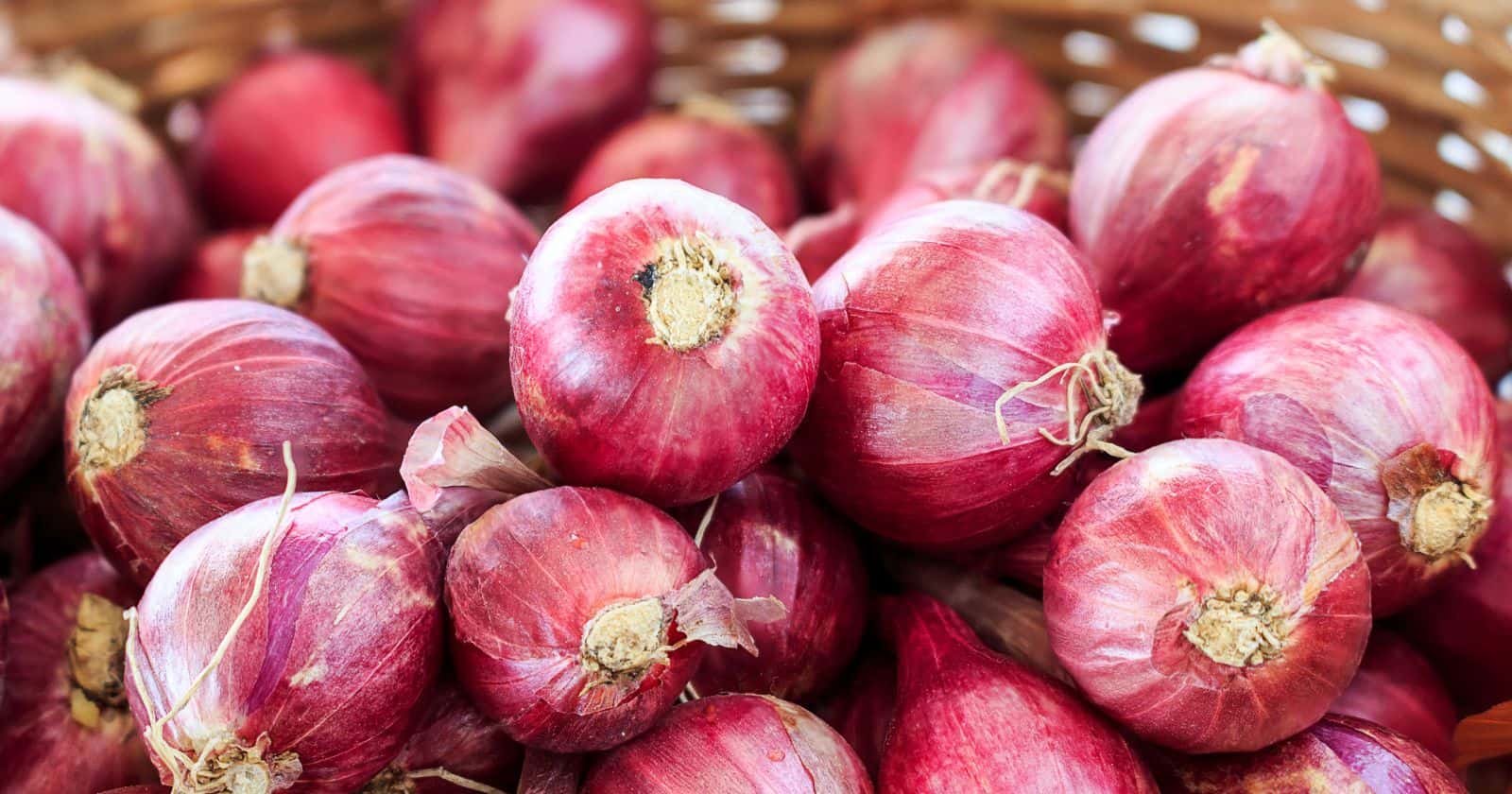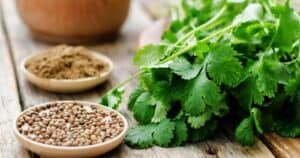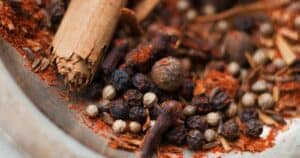If you’re a foodie or a home cook looking to ramp up your pantry game, this post is for you. Keep reading if you’ve ever wondered what the fuss is about shallots or how to use them in your cooking.
In this post, we’ll delve into shallots’ history and origins to their culinary uses and health benefits.
We’ll also explore tips on selecting, chop, and storing shallots and share some delicious recipes to inspire your culinary creativity.
So buckle up, and let’s dive into the world of shallots.
What Are Shallots?
What are shallots? Shallots, a bulb vegetable in the allium family, are related to onions and garlic. They are not just small onions but a separate relative known as Allium ascalonium.
Shallots have a mild, sweet flavor and are often used in French cuisine to add depth of flavor to dishes like vinaigrettes, sauces, and soups.
They may be eaten raw or cooked and are typically sliced thinly or minced before being added to recipes.
Shallots are a great source of vitamins and minerals, such as vitamins C, A, and potassium. They also contain antibacterial and anti-inflammatory compounds, which may provide several health benefits, such as reducing the risk of certain diseases.
In addition to their use in French cuisine, shallots are also popular in other Asian and Mediterranean cuisines, such as Thai and Italian.
They come in different varieties, including gray shallots, Dutch yellow shallots, and French gray shallots.
Each type has a slightly different flavor profile, but all share the same mild, sweet flavor, making them versatile ingredients in many dishes.
History And Origins Of Shallots
Shallots have a rich history dating back to ancient times. They were a staple food in ancient Egypt and were considered a sacred plant by the Persians.
The Crusaders brought them to Europe in the 12th century, and the French regions of Brittany and Anjou became famous for cultivating them.
The word “shallot” is derived from the Old French word cologne, which comes from the Latin Ascalonia cheap or “onion of Ascalon.”
While it’s uncertain where shallots originated, they have no wild counterpart and seem to have developed in Central Asia.
In South India, shallots are called “sambar onions” and are used extensively in cooking. They have played a vital part in various traditional cuisines worldwide for centuries, from French cuisine to Iranian cooking.
Culinary Uses Of Shallots
Shallots are a fantastic ingredient for cooking and can add a touch of sophistication to many dishes.
Here are some of the most popular and versatile ways to use shallots in your cooking:
- Sauteed Shallots: Shallots can be sauteed to create a flavorful base for stews, soups, casseroles, and quiches. They can also enhance the flavor of sauces, stocks, and gravies.
- Roasted Shallots: Roasting shallots can provide a delicious accompaniment to meat dishes or can be used as a side dish. Coat shallots in olive oil, wrap them in foil, and roast in the oven until they are soft and caramelized.
- Pickled Shallots: Shallots can add a tangy flavor to salads or sandwiches. Simply slice them thinly, add vinegar, sugar, salt, and spices, and let them sit in the fridge for a few hours.
- Shallot Dressing: Shallots can be combined with olive oil, vinegar, mustard, and herbs to make a delicious salad dressing for a light and healthy meal.
- Shallot Butter: Adding chopped shallots to butter can create a delightful topping for grilled steak or fish.
- Shallot Tart: Shallots can even be used as the star ingredient in a savory tart. Slice thinly, cook until caramelized and bake in a tasty crust for a delicious and sophisticated dish.
Health Benefits Of Shallots
Shallots are a powerhouse of vitamins and minerals, making them incredibly healthy for your body. They are rich in potassium, which supports various body functions and promotes weight maintenance.
In addition, there are many other health benefits of shallots! With high amounts of antioxidants, flavonoids, and phenols, these tasty vegetables help reduce oxidative damage and keep germs at bay.
Firstly, shallots can help regulate blood sugar levels, which is especially beneficial for people with diabetes. They contain a compound called quercetin, which helps improve insulin sensitivity and reduce inflammation in the body.
This, in turn, can help prevent the onset of a range of chronic diseases such as heart disease, cancer, and certain neurological disorders.
Secondly, shallots are excellent for improving heart health. The antioxidants and potassium in them help limit cholesterol absorption and reduce the risk of developing cardiovascular diseases.
Shallots can also help lower blood pressure levels, another risk factor for heart disease.
Lastly, shallots are also great for promoting bone health. They contain various minerals, such as calcium and manganese, which help build and maintain strong bones.
Additionally, their high antioxidant content is thought to help prevent oxidative damage to bones and joints, which can lead to conditions such as osteoporosis.
How To Select The Perfect Shallots
Choose firm and heavy ones with no soft spots or signs of mold or decay. For a more oniony flavor, go for larger shallots. If you prefer sweeter flavors, pick smaller shallots. Avoid dehydrated or shriveled shallots, as they tend to have less moisture.
Did you know that shallots are a type of onion that are milder in flavor and slightly sweeter? They also come in various shapes and sizes. Here are more tips to help you select the perfect shallots:
- Look for shallots with dry, papery skins. This indicates that they were harvested at the right time and have a longer shelf life.
- Avoid shallots with green sprouts coming out of them as they tend to be overripe or past their prime.
- Choose shallots that are smooth and uniform in shape. Irregular shapes may indicate that they need to be well-grown.
- Some varieties of shallots have reddish skin, while others are golden brown. The color doesn’t affect the quality, so choose your preference.
Chopping And Storing Shallots
Chopping and storing shallots is a simple and easy process. To keep whole shallots, you can put them in the fridge uncovered.
But if you’ve already chopped or sliced them, it’s essential to seal them in an airtight container or food storage bag to keep them fresh. Remember to keep them away from moisture to prevent spoilage.
For more extended storage, you can cure the shallots first by leaving them in a warm and dry place for one to two weeks. After curing, remove the dry foliage and place the bulbs in mesh bags or pantyhose.
This way, you can keep them fresh for a more extended period. Hang them in a dry garage, cellar, or closet.
If you have leftover chopped shallots, you can preserve them in the fridge by sealing them with saran wrap or an airtight container.
This prevents air and moisture from entering and spoiling them. Also, it’s best to keep the shallots manageable, as it can lead to them drying out quickly.
Shallots Substitute
You have many options to choose from depending on your dish. Here are a few substitute ideas:
- Yellow, red, and white onions are suitable substitutes for shallots in cooked dishes.
- Leeks, scallions (green onions), chives, and garlic can also be substituted.
- Yellow onions have a similar flavor profile to shallots and can be used in most recipes.
- Red onions are perfect for raw dishes like salads or dressings.
- Leeks have a milder flavor than shallots but work well in soups and stews.
- Garlic is also an excellent substitute for shallots in many recipes but should be used sparingly.
Consider the flavor and texture you try to achieve when selecting a substitute. With these options, you can find the perfect replacement for your following delicious recipe.
Yellow Onions:
Yellow onions are great for cooked dishes that require a strong onion flavor. They have a similar taste to shallots and are versatile in the kitchen.
They hold up well in dishes like stews, casseroles, and sauces. Use yellow onions when a recipe calls for chopped or diced shallots.
Red Onions:
Red onions are the way to go if you need a substitute for raw shallots. They offer a sweet onion taste that’s perfect for salads or dressings.
They have a firm texture and hold up well in cold dishes. When substituting for shallots in a recipe, make sure to use a small amount of red onion to prevent overpowering the plate.
Leeks:
Leeks have a mild onion flavor and are perfect for soups and stews. They also work well in stir-fries and quiches.
When using leeks as a substitute for shallots, slice them thinly and sauté them in butter until they become soft and translucent.





